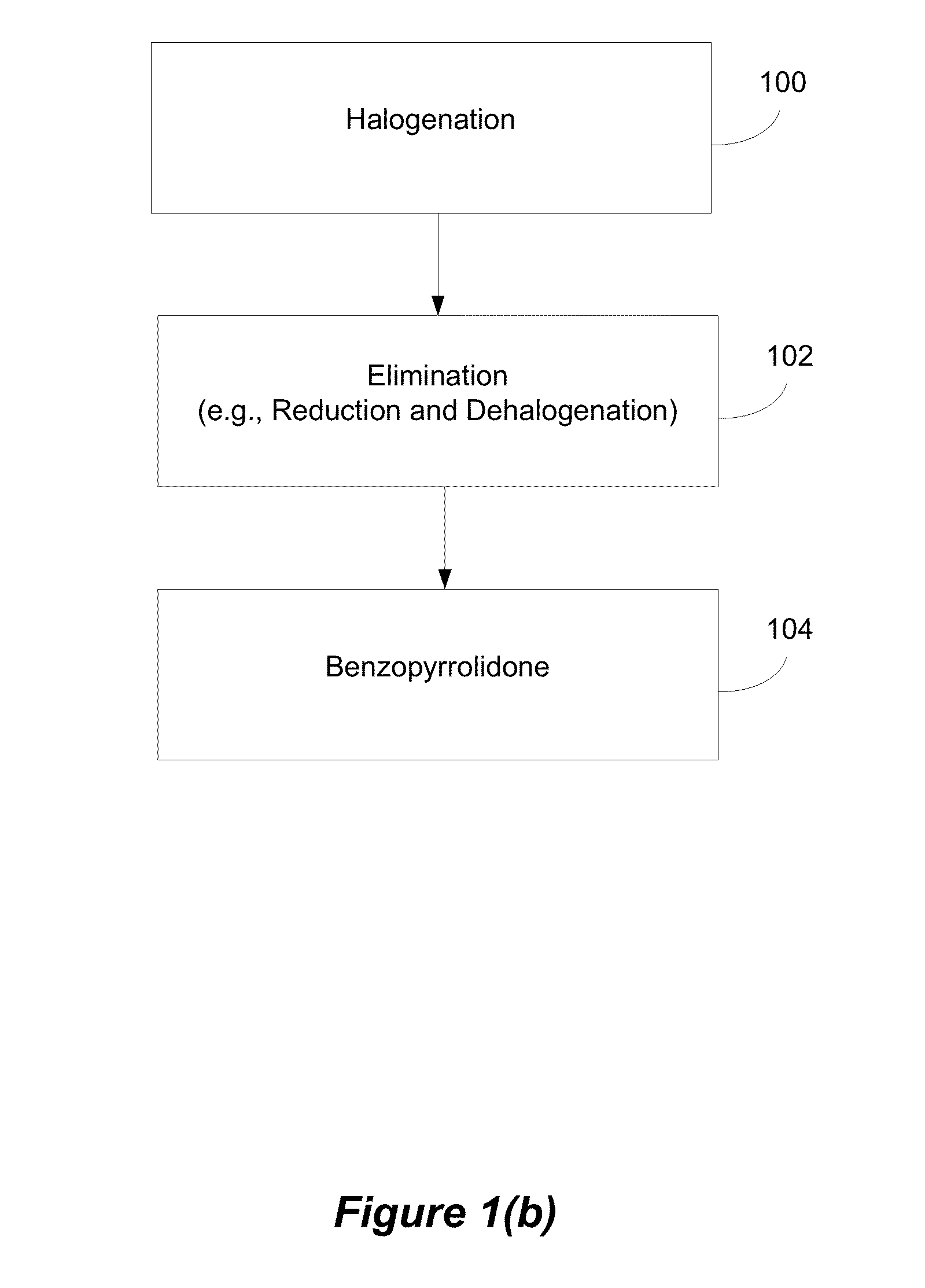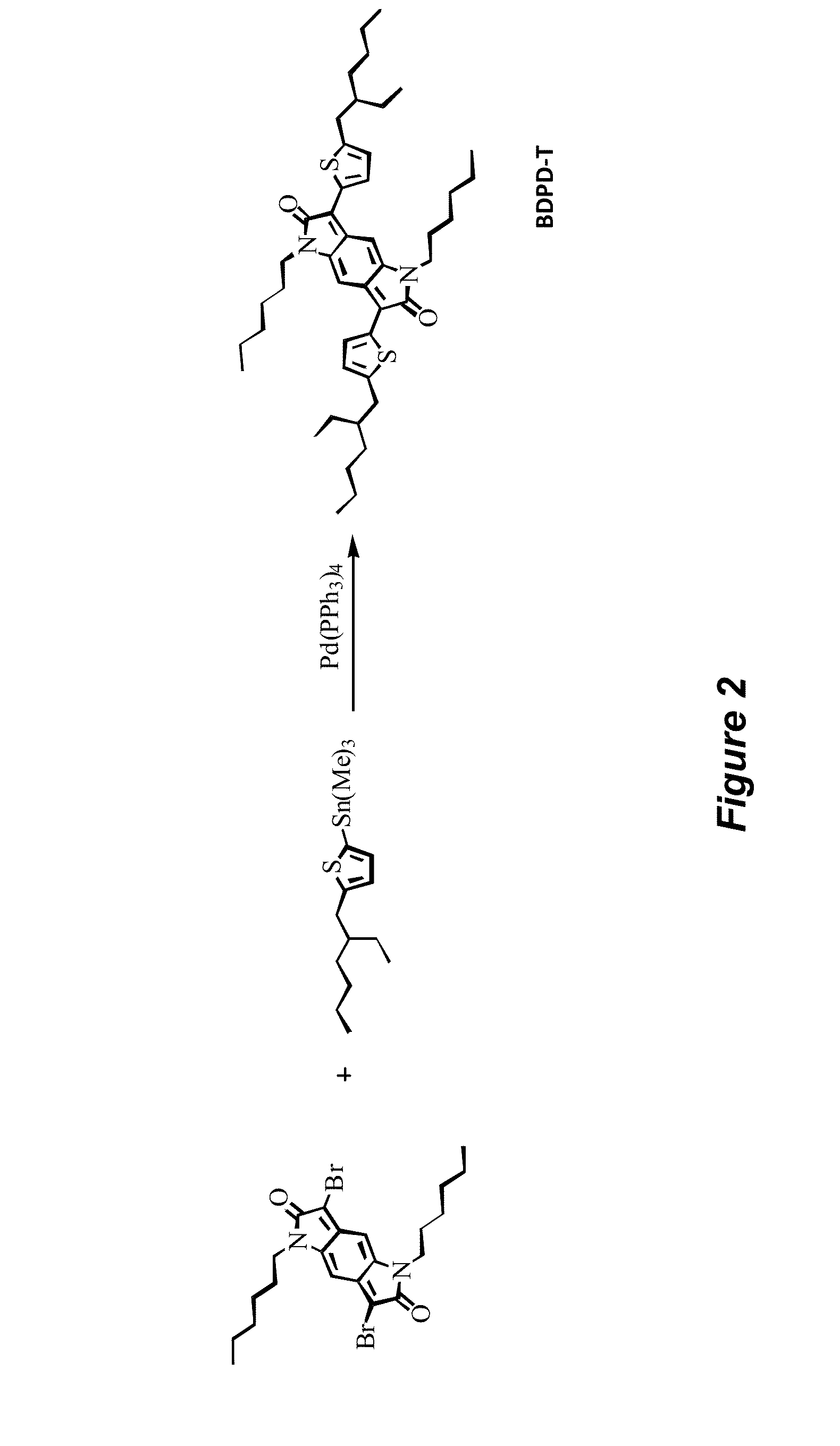Benzodipyrrolidones and their polymers: synthesis and applications for organic electronics and optoelectronics
- Summary
- Abstract
- Description
- Claims
- Application Information
AI Technical Summary
Benefits of technology
Problems solved by technology
Method used
Image
Examples
example 1
For Preparation of Compound A (See FIG. 1(a))
[0085]E.g., preparation of N,N′-Dihexyl-benzene-1,4-diamine: To a solution of cyclohexane-1,4-dione (5.60 g, 50.0 mmol) in ethanol (500 mL) was added hexylamine (10.1 g, 100 mmol). The resulting mixture was stirred under bobbling air for 4 hours (h). Solvent was removed under reduced pressure. The residue was purified by column chromatography on silica gel with hexane: DCM: ethyl acetate=10:10:1 as eluent to yield a light yellow solid (8.50 g, 61.5%). 1H NMR (CDCl3, 600 MHz) δ ppm 6.58 (br, 4H), 3.05 (br, 4H), 1.59 (br, 4H), 1.31-1.38 (m, 12H), 0.88-0.92 (m, 6H). 13C NMR (CDCl3, 600 MHz) δ ppm 140.96, 114.74, 45.42, 31.70, 29.78, 26.91, 22.63, 14.03.
example 2
For Preparation of Compound B (see FIG. 1(a))
[0086]E.g., preparation of N,N′-1,4-Phenylenebis[2-chloro-N-hexyl]acetamide: To a solution of chloroacetylchloride (0.402 g, 3.56 mmol) in THF (5 mL) at 0° C. was added a solution of N,N′-dihexyl-benzene-1,4-diamine (0.300 g, 1.19 mmol) and 4-(dimethylamino)pyridine (DMAP) (0.135 g, 1.11 mmol) in THF (10 mL) dropwise. After 1 h, the reaction mixture was quenched with water. The precipitate was collected by filtration. After being washed with water and methanol, the solid was dried in vacuo to yield a white solid (0.37 g, 72.5%). 1H NMR (CDCl3, 600 MHz) δ ppm 7.32 (s, 4H), 3.82 (s, 4H), 3.27 (t, J=7.8 Hz, 4H), 1.53-1.55 (m, 4H), 1.26-1.32 (m, 12H), 0.87-0.88 (m, 6H). 13C NMR (CDCl3, 600 MHz) δ ppm 165.64, 141.51, 129.65, 50.21, 41.73, 31.41, 27.51, 26.31, 22.49, 13.95.
example 3
For Preparation of Compound C (See FIG. 1(a))
[0087]E.g., preparation of 1,5-Dihexyl-5,7-dihydro-1H,3H-pyrrolo[2,3-f]indole-2,6-dione: A mixture of N,N′-1,4-phenylenebis[2-chloro-N-hexyl]acetamide (5.00 g, 11.6 mmol) and anhydrous aluminum chloride (10.8 g, 81.5 mmol) was heated at 190° C. for 20 min. After cooling, cracked ice was added to quench the reaction. The precipitate formed was collected by filtration. After being washed with water and methanol, the solid was dried and further purified by column chromatography on silica gel with DCM:ethyl acetate=10:1 as eluent to yield a white solid (2.88 g, 70%). 1H NMR (CDCl3, 600 MHz) δ ppm 6.77 (s, 2H), 3.65-3.69 (m, 4H), 3.54-3.55 (m, 4H), 1.64-1.67 (m, 4H), 1.25-1.65 (m, 12H), 0.87-0.89 (m, 6H).
PUM
| Property | Measurement | Unit |
|---|---|---|
| Length | aaaaa | aaaaa |
| Composition | aaaaa | aaaaa |
| Structure | aaaaa | aaaaa |
Abstract
Description
Claims
Application Information
 Login to View More
Login to View More - R&D
- Intellectual Property
- Life Sciences
- Materials
- Tech Scout
- Unparalleled Data Quality
- Higher Quality Content
- 60% Fewer Hallucinations
Browse by: Latest US Patents, China's latest patents, Technical Efficacy Thesaurus, Application Domain, Technology Topic, Popular Technical Reports.
© 2025 PatSnap. All rights reserved.Legal|Privacy policy|Modern Slavery Act Transparency Statement|Sitemap|About US| Contact US: help@patsnap.com



